What Is The Term For A Preparatory Drawing An Artist May Create Before Undertaking A Work?
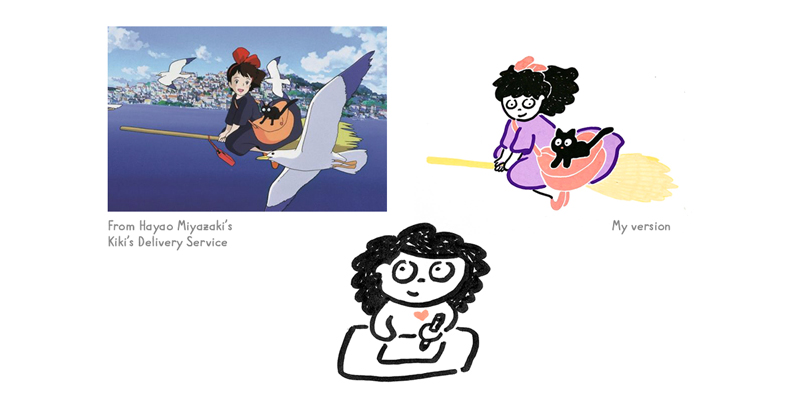
Accept you e'er copied another artist's artwork? Do you experience bad because you find it hard to draw without copying another creative person'south piece of work? Many new artists think almost copying in 1 of two means:
- Copying is a shameful human activity—something to be subconscious.
- Copying is an unethical act—something to be avoided.
But yous guys, there's aught wrong with copying, equally long equally you follow some best practices. And in fact there are many reasons you should copy. Nearly every artist's journey begins with imitating other artists. Over time, the experience leads them to explore and observe their ain style and vocalisation.
There are four basic intentions that lead people to copy other artists. Let's take a wait!
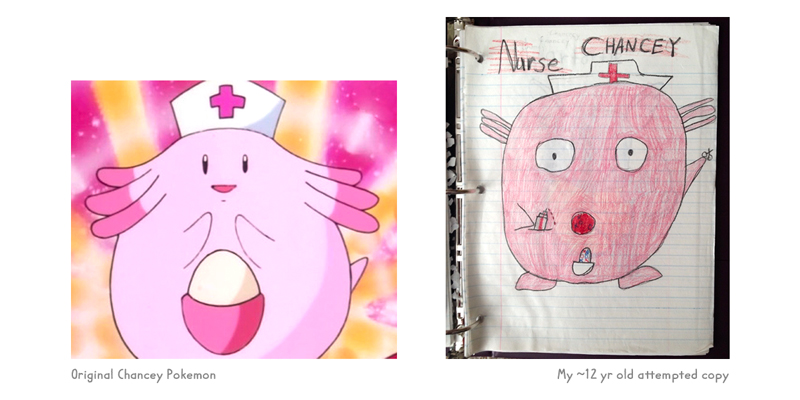
Copy to Imitate + Larn
"Imitation is non just the sincerest form of flattery—it's the sincerest form of learning." –George Bernard Shaw, playwright
It is extremely common for people new to drawing to copy other pieces of fine art. Information technology'south ane of those things anybody does, just no one talks about, so anybody thinks they're the only one. I did information technology myself for years and I'm willing to bet you did as well!
I spent a huge portion of my childhood copying page afterward page of Pokemon and Crewman Moon. I was trying to copy every shape, line, and color as closely to the original every bit I could—I was literally copying them. Not tracing, which teaches you nothing, but copying, which can teach you a great deal.
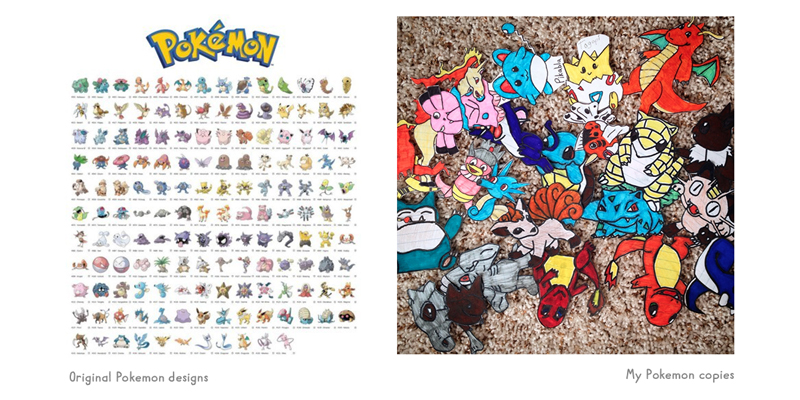
I copied because I wanted to acquire how the animators drew all these characters I loved. I wanted to learn how to draw from a mechanical point of view: how do I motion my pencil on the page to get my lines to look like those? It was simply by copying again and again, over and over, that I was able to train my hand to move in a style I could command.
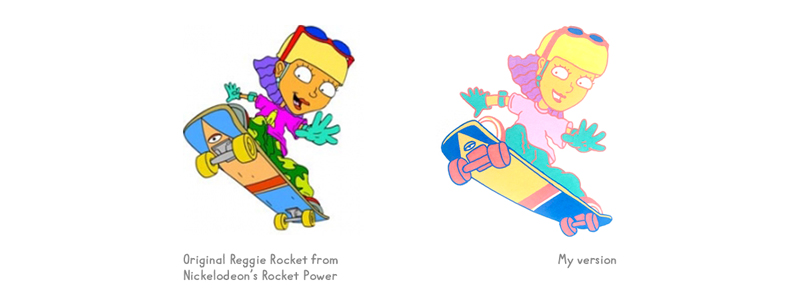
My Copy to Learn phase primarily happened in the 90'south, before social media or blogging exploded, then these drawings were stuffed within a three-band binder and more often than not kept to myself. Now, in the era of the internet and social media, things are a bit more sticky with what to do with these drawings. Come across the end of this essay for all-time practices in sharing copied art.
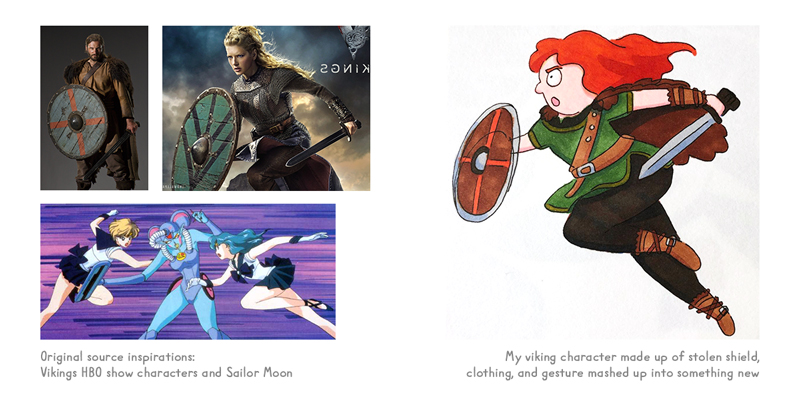
Copy to Steal + Combine
"If you retrieve a man draws the type of hands that you lot want to draw, steal 'em. Take those hands." –Jack Kirby, comic book artist
But drawing isn't just mechanical movements across a page. There are other deeper things going on when we draw. Attempting to draw authentic copies of other artworks is great for teaching united states of america the rules and principles of art. But at some bespeak, to make your own original art, you lot have to choose which rules you want to follow and which you desire to chuck out the window.
Later a while, I became bored of copying Pokemon and thought it would be cool to brand up my ain Pokemon creatures. And that'south when my intention of copying shifted to the next stage. Every bit I started cartoon my own Pokemon creatures, I was all the same copying in many means, but my intention was no longer to imitate and acquire. My new intention was to steal and combine.
I lifted pieces of unlike Pokemon—eyes from Jigglypuff, legs from Bulbasaur, tail from my pet cat, Elvis—and mashed them up together to create a make new Pokemon—my ain Pokemon. Little did I know, I was on my way to making my first pieces of art.
"It's not where you take things from—it's where you take them to." –Jean-Luc Godard, movie director
If you copy something line for line, aiming for an exact replica, you lot haven't made art. You've only made a re-create of someone else's fine art. But if you have little bits and pieces from many dissimilar sources and modify and combine them in new ways, you lot've now created something new and original—yous've created art.
Copying with the intention to steal begins with a spark of inspiration. I loved and was inspired by the artistic elements of Pokemon, and my intention was to create something new from that inspiration. That's what art is: taking an idea, combining it with other ideas in your head, and making a new idea.
Information technology'due south impossible to not be influenced by the things around us—it's the very essence of creativity. Everything we create is a mashup of everything we've seen, heard, felt, and experienced. All these things together, from Pokemon to Sailor Moon to my pet cat, make up my artistic influences. And new influences are constantly absorbed into us becoming office of our always-evolving artistic voice.
If I had never seen Pokemon, I would draw today in a completely different way. If I had never read Michael Pollan's Omnivore's Dilemna, I never would have been inspired to create Nosotros Are Fungi. These influences, inspirations, and the human activity of copying to steal and combine are essential parts of the artistic process. Ideas create ideas. Art creates fine art.
"Zero is original. Steal from anywhere that resonates with inspiration or fuels your imagination. Devour old films, new films, music, books, paintings, photographs, poems, dreams, random conversations, architecture, bridges, street signs, copse, clouds, bodies of water, light and shadows. Select merely things to steal from that speak directly to your soul. If you practise this, your work (and theft) volition be authentic." –Jim Jarmusch, film director + screenwriter
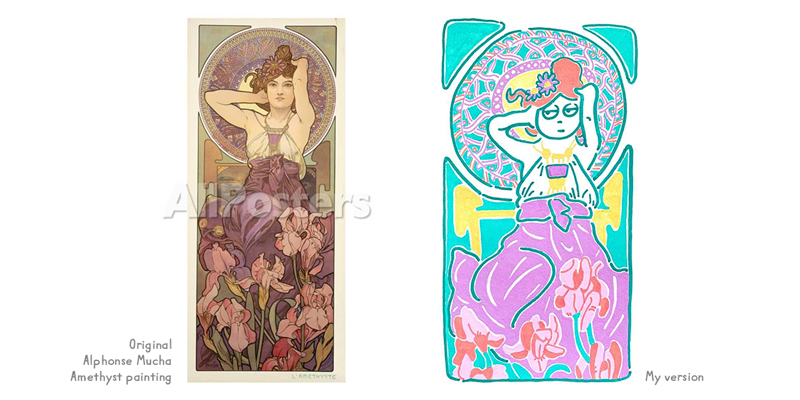
Copy to Honor + Play
"Those who exercise not want to imitate annihilation, produce nothing." –Salvador Dali, painter
Nosotros artists oftentimes feel pressure to sit downwards and draw something completely original every fourth dimension they depict. But making original art takes a certain mindset, inspiration, and energy level, and let'south be honest: sometimes it's just not at that place. So if we're aiming to draw consistently (which you lot are, aren't you?), we demand a fashion to draw when we don't accept whatsoever idea of what the heck to draw.
1 of my favorite methods of cartoon when I'm depression on creativity is to copy some of my influences. My intention here is to honor something I love and elevator the pressure of cartoon something new—basically, to play on the page.
Information technology'south a flake different than copying to learn, where I'm aiming for imitation and a directly re-create. And it'southward a bit dissimilar than copying to steal and combine, where I'm aiming to take bits and pieces from multiple dissimilar sources, combining them into something new. Copying to play is more than light-hearted. In that location'due south just i source of influence, but my artistic mode is injected in the drawing besides.
This is similar to the popular hashtag, #DrawThisInYourStyle on Instagram. Artists offer up a piece of their art for other creative person'southward to copy in their own way, changing the linework, colors, and overall style, while crediting the original artist and artwork. In this method, the artists are non copying the piece closely enough to be learning, and they're not deviating enough from it or stealing enough from other sources for information technology to be combining. It's right in between: it'southward playing. Information technology'due south a fun way to draw, when you just desire to draw.
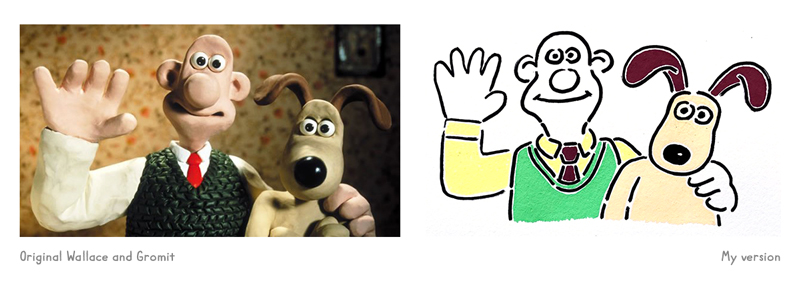
I'grand actually feeling low on creative energy right now (helloooo month 8 of pregnancy!), so I made this calendar week'southward #MightCouldDrawToday theme Wallace and Gromit, the British claymation serial, with this intention in mind. Throughout the week, we'll be looking at these claymation characters and drawing our own versions of them in our ain styles. My intention is to share this influence I love, and give myself (and you guys!) a creative outlet that's easy to approach in a depression energy mood.
So far all these methods of copying have been good—they're beneficial and assistance u.s.a. abound equally artists in many dissimilar means. But what happens if we movement beyond the intentions of learning, stealing and playing? Can copying exist bad?
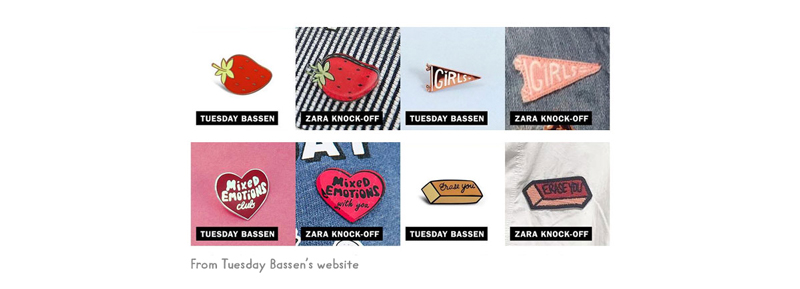
Copy to Plagiarize
"Copying opens your eyes to new possibilities, and new techniques… but trying to play tricks information technology off as your own is quite another matter." –Louise Bunn, sculptor + painter
Let me exist crystal clear: Plagiarism is wrong. According to the Merriam Webster Lexicon to plagiarize is "to steal and pass off (the ideas or words of another) as i'south own; to employ (another'south production) without crediting the source."
You lot may be thinking: and then you're saying copying, stealing, and playing are proficient, but plagiarizing is bad? What'southward the difference? How do we know where the line is?
It always comes back to intention. We've talked virtually copying with the intention to learn, to create something new, and to honour and play. Merely sometimes, a person copies with the intention of taking advantage of another artist. Or the intention of skipping the difficult piece of work of creating their own original fine art and passing someone else'due south art as their own. Or the intention to profit off someone else'south art.
There are so many horror stories out in that location of artists getting their piece of work plagiarized. Sometimes it's a random person on the internet passing off someone else's piece of work as their own. Sometimes it's a huge corporation selling blatant copies of an artist'southward work without crediting or paying them, similar Tuesday Bassen and Zara in the image higher up.
Either way plagiarism is unethical, and no practiced comes from it. It's hurtful to the plagiarized creative person, straight affecting their careers and income, and it's unhelpful to the plagiarizing person considering they're just short-irresolute themselves of true creativity and not creating art authentic to themselves.
Influences are meant to create inspiration, not dishonest imitations. I believe copying is an essential function of learning to describe, but yous HAVE to be honest with yourself and others nigh what you lot're doing. If you copy a piece of art and share information technology online, y'all demand to credit the original influence.
If you're confused or unsure most your intention, here's an easy gut check when y'all're considering sharing your work: Do you experience the need to hide who or what influenced your drawing? If yous're not willing to share your sources, then you're probably not drawing with an intention of learning, creating something new, or playing, and this may exist a slice of artwork yous should keep to yourself. Private artworks tin be a source of learning too, and we don't have to share everything we make. Copying simply becomes plagiarizing if you attempt to pass it off someone else's work equally your own.
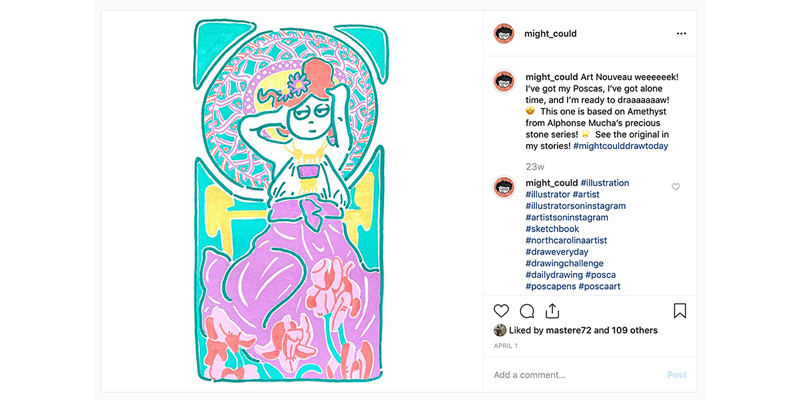
Best Practices of Copying
I think this may exist why people are scared to admit to or talk near copying. But as long as you're honest with yourself and others, copying tin can be a successful part of whatsoever artist's evolution. Hither are a few all-time practices to keep in heed when you're copying, and especially when you're thinking of sharing artwork spurred from copying:
Learning/Imitating + Honoring/Playing
If y'all copy a piece of art with the intention of learning or playing and want to share it online: credit the original source. Let people know you are copying, what yous're copying, and if non a well-known franchise like Pokemon, who y'all are copying. Be honest.
Stealing/Combining
If you copy a piece of fine art with the intention of stealing and desire to share information technology online, consider: did you steal from enough sources and alter the original ideas enough to create something new? If yep, awesome, you fabricated some original art! Share away!
If you only had one influence, or wouldn't want to show people your source influences because your version is also close to the original, or if you're not sure: y'all should credit the original source/influence/creative person.
Plagiarizing
If you copy a slice of art with the intention of claiming someone else's fine art as your ain or profiting off some other artist's work: DON'T.
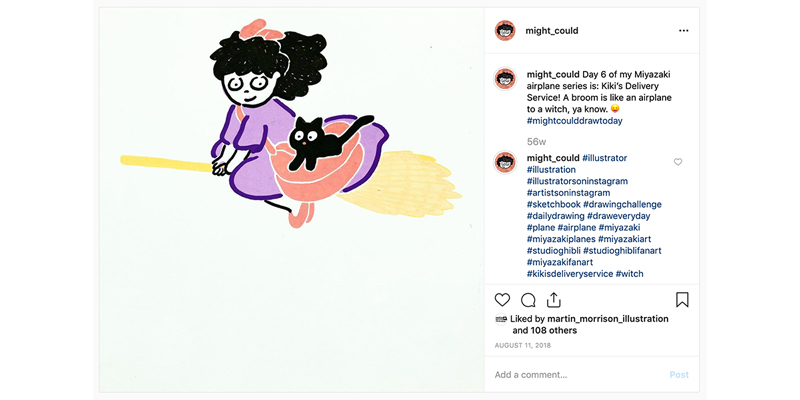
All Yous Need to Know
Copying is a part of well-nigh every artist'southward development. Copying another artist'due south work tin be a wonderful way to larn, get inspired, go ideas, honor an influence y'all dear, and create something new. All art is a mash up of ideas, and we can all influence and inspire each other, then long as nosotros are creating and sharing from a place of honesty and transparency.
Then learn abroad, play away, steal away, copy, copy, copy, and don't forget to credit your influences!
I started noticing something [all my favorite artists] had in mutual—they all copied each other… I realized that this is what artists are supposed to practise—communicate back and forth with each other over the generations, take erstwhile ideas and brand them new (since it's impossible to actually "imitate" somebody without adding annihilation of your own), create a rich, shared cultural linguistic communication that was bachelor to everybody. Once I saw it in folk art, I saw it everywhere – in hip-hop, in street fine art, in dada. I became convinced that the soul of culture lay in this kind of weird, irreverent-but-reverent backs-and-forth." –Will Sheff, singer
Thanks for reading!
<three,
Christine
What Is The Term For A Preparatory Drawing An Artist May Create Before Undertaking A Work?,
Source: https://might-could.com/essays/inspiration-vs-imitation-how-to-copy-as-an-artist/
Posted by: puafrod1948.blogspot.com


0 Response to "What Is The Term For A Preparatory Drawing An Artist May Create Before Undertaking A Work?"
Post a Comment